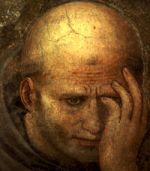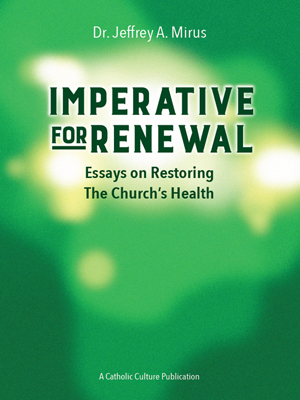Catholic Myth Busting: One Step Is Often Enough
By Dr. Jeff Mirus ( bio - articles - email ) | Oct 18, 2012 | In Reviews
One of the interesting things about misunderstandings of the Catholic Church is this: If we are able to dispel one misunderstanding for a particular person, we’re well on the way toward dispelling all of that person’s misgivings concerning the Faith. This is true largely because of the hidden motives which tend to produce and govern such misunderstandings.
For example, if a person has been genuinely and uniformly misled about the Church over a period of time, but has nothing in his personal desires which consciously or subconsciously drives him away from the Church, then when that person finds he has in fact been misled about the Church in a particular area, he begins in all honesty to wonder if the Church herself might actually be more trustworthy than the sources on which he has previously relied. This was very much the case, for example, with Joseph Fadelle, the Muslim who converted to Catholicism at immense personal risk and told his story in The Price to Pay (a review is forthcoming). And I suspect many of us know of others for whom this has also been true.
On the other hand, if a person has a strong personal motive for ignoring or opposing the Church, it is doubtful that he will be able to admit that even one misunderstanding has ever been successfully dispelled. In other words, if through pride or lust or greed or bad relationships or social status, a person consciously or subconsciously views the Catholic Church as something that must be wrong—an institution whose claims must, at all costs, be rejected—then the best arguments in the world on any given point of misunderstanding will be repelled with a closed mind. We won’t be able to dispel even the first misunderstanding.
This is not an argument against bearing witness to the Faith even when it is unlikely to have an immediate impact. To the contrary, as Blessed John Henry Newman pointed out, human memory can, in a sense, become “Christian memory”, in that we never know when something we said might be recalled, under the influence of the Holy Spirit, at just the right moment to begin an important process of change.
But it does mean that we seldom need to worry about covering all the bases with everybody. Often the right words to the right person about a particular topic which interests that person at the current moment will be enough to trigger the whole desired result. It is not infrequently an initial, specific realization that begins the whole process of conversion, the realization that “the Church is not what I thought it was” or that “God really loves me” or that “I find this Catholic more attractive than I thought possible” or that “the authorities I’ve trusted in the past have betrayed me in this matter” or that “Catholic teaching actually makes sense here”.
With this in mind, partial discussions of common misperceptions of the Catholic Church become far more important. Witnessing to the Faith seldom encompasses a full evangelization or catechesis, though it can certainly include these things. But there are far more opportunities to bear witness than there are to formally preach the Gospel (evangelization) or to systematically expound Catholic doctrine (catechesis). Most often, we’ll be engaged in almost random discussions of issues which touch on how others perceive Catholicism. What we say on those occasions can ignite a self-driving thirst for much, much more.
For example, in various discussions, people may be stunned by a Catholic’s interest in and familiarity with science; or by a faithful Catholic’s concern for human welfare; or by the respect a Catholic apologist has for women. Similarly, people may find surprisingly attractive the Catholic vision of the unity between love and procreation. Or they may seriously demand to know why the Church “hates homosexuals”, and be thrown for a loop by the answer. Or we may correct them—occasionally with good results—when they offhandedly remark that there is no rational basis for restricting marriage to one man and one woman, or that priestly celibacy causes pedophilia.
Such small and very specific surprises are very dangerous to the complacency with which many people in our culture have accepted a wide variety of myths about Catholics and the Catholic Church. This complacency often goes unrecognized. While we seldom have opportunities to make the whole case for Catholicism to our neighbors, we should take comfort in the fact that making the whole case is seldom necessary. For the person who is genuinely interested in knowing the truth and living rightly, the first step in a great many cases is to dispel just one myth, to astonish the person by the realization that truth and goodness might actually be found in what seems to be a most unlikely place.
This understanding of how conversion works should always be kept in mind, but it also demonstrates the effectiveness of a new book I want to call to your attention: The Seven Big Myths about the Catholic Church, by Christopher Kaczor. The author is a professor of Philosophy at Loyola Marymount University and a remarkably easy-to-follow writer. He dispels precisely the kinds of misperceptions, misunderstandings and myths which I used as examples two paragraphs back. Specifically, he refutes the following:
- Catholicism is irrational and anti-scientific.
- The Church, indifferent to earthly welfare, stands in the way of freedom and happiness.
- The Church demeans women.
- Catholic teaching on contraception demonstrates Catholic indifference to human love.
- Catholicism is fundamentally homophobic.
- The Church is bigoted in its opposition to same-sex marriage.
- Priestly celibacy causes priestly pedophilia.
There are of course, many other myths about the Faith which could be dispelled, but these seven are a good sampling of the general and specific misconceptions prevalent in Western culture at the present time. Often these misconceptions simply make good axes to grind for those whose self-indulgence or self-interest lead them to attack the Church. But they are often also held relatively innocently as part of the general thought patterns of the larger culture. In these cases, they create attitudes which cause people who would otherwise be open to Christ to look elsewhere in their search for good sense.
Kaczor’s genius consists in clarifying each question, marshaling the relevant evidence from a wide variety of sources, and illuminating the logic of the Catholic position. Because of the welcome efficiency of the book—it covers each topic in just fifteen to thirty tightly-focused pages—I find it hard to imagine a more efficient way to get up to speed. The book would also make an excellent gift for anyone who is already on his way home and eager to learn more. But the larger point in the context of this essay is that, if you can learn from Kaczor how to handle these seven problems, you’ll have plenty of opportunities to make effective comments on Catholic teaching, Catholic positions and Catholic practice in the discussions so common in our highly distressed culture.
The right words at the right times will make up the fertile soil out of which the New Evangelization will grow.
All comments are moderated. To lighten our editing burden, only current donors are allowed to Sound Off. If you are a current donor, log in to see the comment form; otherwise please support our work, and Sound Off!
-
Posted by: FredC -
Oct. 20, 2012 10:06 AM ET USA
You may also listen to Kaczor talk on the seven myths at http://www.catholic.com/radio/shows/the-seven-big-myths-about-the-church-7582 (54 minutes).








